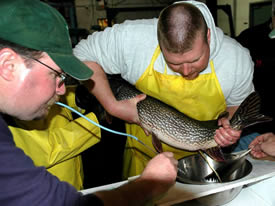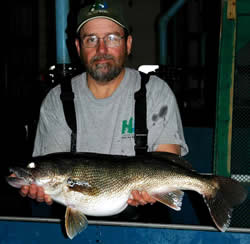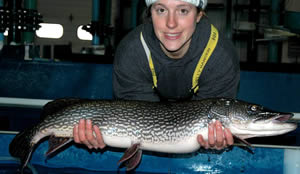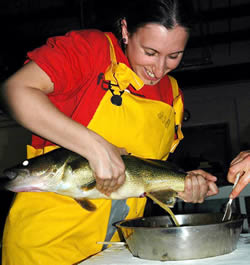|
by
Craig Lemon
Hatchery Superintendent, and
Ed Washuta,
Fisheries Pathologist
May, 2006
The
2006 spring trap-netting season began right on schedule on March 12
when the Hackettstown Hatchery
crew set their nets on Budd Lake to collect northern pike broodfish,
and proceeded without a hitch through the end of musky collection
April 27th on Echo Lake Reservoir.
|
|
The
spring climate was mild and dry which allowed the netting crew
to get an early start on Budd Lake. Over the nine-day netting
period, the crew captured a total of 213 northern pike of which
157 were males and 48 were females. Male pike ranged in length
from 16-28 inches and weighed an average of 2 pounds. Female
pike were slightly larger at 19-34 inches and averaged 3.5 pounds.
Two of the northern females weighed in at over 10 pounds with
largest being ripe 12.5 pounder.
Eggs
were collected from 25 Budd Lake northern females. The average
female northern produced 24,409 eggs for a total production
of 622,430 eggs, of which 64.3% or 400,106 hatched. The hatch
rate is comparable to the long-term rate of approximately 65%.
Over the next two-month period, the number of pike will be culled
down to the 23,000 top-quality six to seven-inch fingerlings
for stocking in New Jersey lakes.
|
|
After
completing a successful northern pike broodstock season on Budd
Lake, the Hackettstown Hatchery crew set their nets in Cranberry
Lake on March 22nd. Their goal was to collect data on the lake's
fish population and to evaluate its potential as a northern
pike broodstock lake. In five days of trapnetting only two northern
pike were collected. Both were five to six pound adult females.
Hatchery
workers were encouraged by the capture of spawning condition
pike and plan to return to Cranberry Lake next year in an attempt
to locate the bulk of the spawning population of pike. Low water
flows from tributary streams into the lake may have accounted
for the failure of pike to congregate in areas where the trapnets
were set.
|
 The
author adds milt as Crew Supervisor Ed Conley strips eggs from
a northern pike.
The
author adds milt as Crew Supervisor Ed Conley strips eggs from
a northern pike.
Click
to enlarge |
 Fisheries
Worker Steve Strodel with ripe Swartswood Lake walleye.
Click
to enlarge
Fisheries
Worker Steve Strodel with ripe Swartswood Lake walleye.
Click
to enlarge |
The
very dry month of March was also reflected in the conditions
of Swartswood Lake where the water level was about 2 to 2.5
feet below normal, compounded by a fall drawdown of the lake.
The skills of the hatchery trapnetters were tested by the low
water levels, but they were able to meet the challenge by collecting
216 adult walleyes over a ten day period.
The
catch was composed of 146 males and 70 females. This 2 to 1
balance between males and females indicates that the crew timed
the spawning season perfectly. Most of the females captured
were running ripe; only a few were spent (had already released
their eggs). Fifty-two females were spawned to produce 6.5 million
eggs, an average of 124,130 eggs per female. The expected hatchery
pond production of walleye fingerlings is 300,000 two-inchers
and 35,000 four-inchers.
Male
walleyes ranged in size from 13.8 - 21.6 inches, weighing 1.05
- 4.2 pounds. Females ranged from 14.2 - 29.2 inches in length
and 1.3 - 10.06 pounds in weight. The average Swartswood Lake
walleye was 19.6 inches long, exceeding the minimum size limit
of 18 inches, and weighed 3.39 pounds. A remarkable number of
10 females weighed over 6 pounds (about 5% of the catch!).
|
On
April 10th, the Hackettstown Hatchery trapnetting crew moved their
operation north to Greenwood Lake for the dual purpose of collecting
walleye broodstock and muskellunge broodstock. The trapnetters were
successful on both charges. A total of 77 adult walleye were collected
along with 22 muskies. Female walleyes averaged 25 inches long and
weighed 6.5 pounds, while males averaged 17 inches and 2 pounds.
|
The
hatchery crew continued to be successful in muskellunge collection
from Greenwood Lake in 2006 as they were in 2005. In a one-week
period, 22 adult muskellunge (12 males and 10 females) were
captured. The females ranged in length from 34 - 50 inches and
weighed an average of 17 pounds. Males ranged from 25 - 40 inches
and weighed an average of 8.6 pounds. The largest muskie captured
from Greenwood was a 33-pound, 50-inch spent female.
The
final phase of broodstock collection in 2006 was carried out
in Echo Lake Reservoir in Passaic County between April 18th
- 27th. Over that 9-day period, 20 adult muskellunge (12 males
and 8 females) were captured. The muskellunge spawning season
was at its peak, demonstrated by the fact that all 20 fish from
Echo were ripe at the time of collection.
The
average sizes of muskellunge collected at Echo lake were: 43.0
inches and 18.9 pounds for females, and 37.6 inches and 12.2
pounds for males. Ten of the twenty fish captured measured 40
inches or longer. The longest muskie captured was 45.4 inches.
The heaviest weighed 23.5 pounds before spawning. Both of these
fish were females.
|
|
|
|
Twenty-one
female muskies produced a total of 710,616 eggs, an average
of 33,839 eggs per female. Eggs hatched at a rate of 54%, which
is comparable to other years. Muskie fry will be raised to advanced
fingerlings in hatchery tanks and ponds to a size of 10-12 inches
at which time they will be stocked.
All
broodstock collected for use in the hatchery programs were transported
to the hatchery where the spawn taking operations are performed
by hatchery personnel. Within a week of spawning the fish are
returned to the waters where they were collected. All adult
muskies handled at the hatchery over the past several years
have been tagged with orange streamer tags inserted near the
base of the dorsal fin. The tags bear the message "CALL
HACKETTSTOWN HATCHERY (908) 852-4950" along with a
tag number. Anglers who call in to report catching a tagged
fish will be told when the fish was tagged, and its length and
weight at the time of tagging.
The
purpose of the Hackettstown Hatchery's brook stock program is
to provide the eggs from which fish are raised at the hatchery.
All fish raised at the Hackettstown Hatchery are stocked in
public waters throughout the state to provide recreational fishing
for licensed anglers and their families.
|
In
2006, Bureau of Freshwater
Fisheries biologists have requested the Hackettstown Hatchery
to produce the following:
24,520
northern pike fingerlings for stocking in:
Cranberry Lake (Sussex County); Pompton Lake and Pompton River (Passaic
County); Spruce Run Reservoir (Hunterdon County); Budd Lake (Morris
County); Farrington Lake (Middlesex County); Deal Lake (Monmouth
County); Millstone River and the Passaic River.
11,111
muskellunge for stocking in:
Greenwood Lake, Monksville Reservoir and Echo Lake Reservoir (Passaic
County); Lake Hopatcong (Morris and Sussex Counties), D&R Canal
10-mile stretch (Somerset and Mercer Counties); Manasquan Reservoir
(Monmouth County); Carnegie Lake and Mercer Lake (Mercer County);
Mountain Lake and Furnace Lake (Warren County); Shenandoah Lake
(Ocean County); Little Swartswood Lake (Sussex County); and Cooper
River Park Lake (Camden County).
207,950
walleyes for stocking in:
Lake Hopatcong (Morris County), Swartswood Lake (Sussex County),
Greenwood Lake (Passaic County), Canistear Reservoir (Sussex County),
and Monksville Reservoir (Passaic County).
Below
are summary tables of fish collected in Spring, 2006.
NORTHERN
PIKE
|
WATER BODY
|
# DAYS NETS WERE SET
|
# FISH CAUGHT
|
AVERAGE LENGTH (INCHES)
|
LARGEST FISH (INCHES)
|
AVERAGE WEIGHT (POUNDS)
|
LARGEST FISH (POUNDS)
|
|
BUDD LAKE
|
9
|
213
|
21.4
|
34.6
|
2.35
|
12.55
|
MUSKELLUNGE
|
WATER BODY
|
# DAYS NETS WERE SET
|
# FISH CAUGHT
|
AVERAGE LENGTH (INCHES)
|
LARGEST FISH (INCHES)
|
AVERAGE WEIGHT (POUNDS)
|
LARGEST FISH (POUNDS)
|
|
ECHO LAKE RESERVOIR
|
9
|
20
|
39.8
|
45.4
|
14.9
|
23.5
|
|
GREENWOOD LAKE
|
7
|
22
|
36.0
|
50.0
|
12.1
|
33.0
|
WALLEYE
|
WATER BODY
|
# DAYS NETS WERE SET
|
# FISH CAUGHT
|
AVERAGE LENGTH (INCHES)
|
LARGEST FISH (INCHES)
|
AVERAGE WEIGHT (POUNDS)
|
LARGEST FISH (POUNDS)
|
|
GREENWOOD LAKE
|
7
|
77
|
23.0
|
28.8
|
5.4
|
9.5
|
|
SWARTSWOOD LAKE
|
10
|
216
|
19.6
|
29.2
|
3.39
|
10.06
|
|





